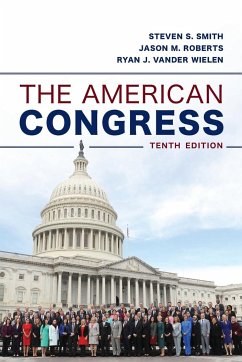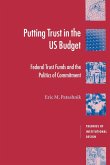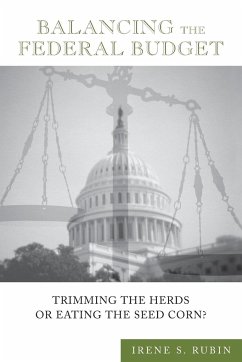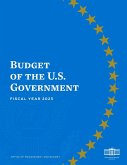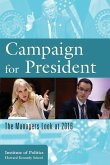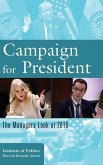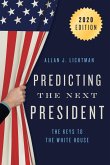- Broschiertes Buch
- Merkliste
- Auf die Merkliste
- Bewerten Bewerten
- Teilen
- Produkt teilen
- Produkterinnerung
- Produkterinnerung
The tenth edition of this core textbook provides a fresh perspective and a crisp introduction to congressional politics. Informed by the authors' Capitol Hill experience and scholarship, the text emphasizes the importance of a strong legislature and offers discussion questions and further reading.
Andere Kunden interessierten sich auch für
![Putting Trust in the U.S. Budget Putting Trust in the U.S. Budget]() Eric M. PatashnikPutting Trust in the U.S. Budget39,99 €
Eric M. PatashnikPutting Trust in the U.S. Budget39,99 €![Balancing the Federal Budget Balancing the Federal Budget]() Irene S. RubinBalancing the Federal Budget45,99 €
Irene S. RubinBalancing the Federal Budget45,99 €![Budget of the United States, Fiscal Year 2023 Budget of the United States, Fiscal Year 2023]() Executive Office Of The PresidentBudget of the United States, Fiscal Year 202327,99 €
Executive Office Of The PresidentBudget of the United States, Fiscal Year 202327,99 €![Campaign for President Campaign for President]() The Institute of Harvard Kennedy SchoolCampaign for President53,99 €
The Institute of Harvard Kennedy SchoolCampaign for President53,99 €![Campaign for President Campaign for President]() The Institute of Harvard Kennedy SchoolCampaign for President118,99 €
The Institute of Harvard Kennedy SchoolCampaign for President118,99 €![Predicting the Next President Predicting the Next President]() Allan LichtmanPredicting the Next President33,99 €
Allan LichtmanPredicting the Next President33,99 €![Campaign for President Campaign for President]() The Institute of Harvard Kennedy SchoolCampaign for President94,99 €
The Institute of Harvard Kennedy SchoolCampaign for President94,99 €-
-
-
The tenth edition of this core textbook provides a fresh perspective and a crisp introduction to congressional politics. Informed by the authors' Capitol Hill experience and scholarship, the text emphasizes the importance of a strong legislature and offers discussion questions and further reading.
Produktdetails
- Produktdetails
- Verlag: Rowman & Littlefield Publishers
- Tenth Edition
- Seitenzahl: 416
- Erscheinungstermin: 17. Juli 2019
- Englisch
- Abmessung: 229mm x 152mm x 22mm
- Gewicht: 600g
- ISBN-13: 9781538125830
- ISBN-10: 1538125838
- Artikelnr.: 56153030
- Herstellerkennzeichnung
- Libri GmbH
- Europaallee 1
- 36244 Bad Hersfeld
- gpsr@libri.de
- Verlag: Rowman & Littlefield Publishers
- Tenth Edition
- Seitenzahl: 416
- Erscheinungstermin: 17. Juli 2019
- Englisch
- Abmessung: 229mm x 152mm x 22mm
- Gewicht: 600g
- ISBN-13: 9781538125830
- ISBN-10: 1538125838
- Artikelnr.: 56153030
- Herstellerkennzeichnung
- Libri GmbH
- Europaallee 1
- 36244 Bad Hersfeld
- gpsr@libri.de
Steven S. Smith, Jason M. Roberts, Ryan J. Vander Wielen
Preface
Acknowledgments
1. The Troubled Congress
Studying Congress
A Partisan, Centralized Congress
Will Polarized Parties, Centralized Decision Making, and Procedural Warfare
Last Forever?
An Unpopular Congress
Other Trends in Congressional Politics
The Changing Congress
Key Terms
Suggested Reading
Discussion Questions
2. Representation and Lawmaking in Congress
Models of Representation
Models of Lawmaking
Rules for Representation and Lawmaking in the Constitution
Beyond the Constitution: The Development of Parties and Committees
Conclusion
Key Terms
Suggested Reading
Discussion Questions
3. Congressional Elections
The Rules Governing Congressional Elections
The Constitution: Eligibility, Voting Rights, and Chamber Size
Federal Law: Apportionment and Campaign Finance
State Law: Redistricting and Primaries
Election Practice Reform
Variations in the Incumbency Advantage
Biased Campaign Funding
Nationalization of Congressional Elections
Midterm Elections
Conclusion
Key Terms
Suggested Reading
Discussion Questions
4. Members, Goals, Resources, and Strategies
Members' Goals
Members' Resources
Influences on Members
Choosing Strategies
Legislative Styles
Conclusion
Key Terms
Suggested Reading
Discussion Questions
5. Parties and Leaders
The Nature of Congressional Parties.
Factions Within Congressional Parties
Party Organizations
Party Leaders
House Party Leaders
Senate Party Leaders
Party Leaders' Resources
Term Limits for Party Leaders
Congressional Leaders and Presidential Succession
A New Party Era
Conclusion
Key Terms
Suggested Reading
Discussion Questions
6. The Committee System
Types of Committees
The Nature of Congressional Committees
The Power of Modern Committees
Declining Committee Autonomy
Committee Membership
Committee Leaders
Conclusion
Key Terms
Suggested Reading
Discussion Questions
7. The Rules of the Legislative Game
Legislative Rules in Perspective
Beyond the Constitution: House and Senate Rules
The Standard Legislative Process
Introduction of Legislation
Referral to Committee
Committee Action
Circumventing Committees
Floor Scheduling
Floor Consideration
Resolving Differences Between Chambers
House and Senate Rules Compared
Authorizing and Appropriating
Evolution of the Legislative Process
Conclusion
Key Terms
Suggested Reading
Discussion Questions
8. The Rules of the Game: The Budget Process
Overview of the Federal Budget
Creating a Congressional Budget Process: 1974
The Pliable Budget Process
The Multiple Legislative Personalities of Tax Legislation
The Multiple Legislative Personalities of Spending Bills
The Battle over Earmarks
Conclusion
Key Terms
Suggested Reading
Discussion Questions
9. The Floor and Voting
Voting Procedure
Analyzing Votes
Conclusion
Key Terms
Discussion Questions
Suggested Reading
10. Congress and the President
The President as a Legislative Player
Presidents' Strategies
Presidential Resources
Congressional Resources and Strategies
Ideological Outlook
The Divided-Government Debate
Conclusion
Key Terms
Suggested Reading
Discussion Questions
Chapter 11. Congress and the Courts
Courts as Umpires
Judges as Policy Makers
Congressional Resources and Strategies
Conclusion
Key Terms
Suggested Reading
Discussion Questions
12. Congress, Lobbyists, and Interest Groups
The Expanding Community of Lobbyists and Interest Groups
Developments in Interest Group Strategies
Inside Lobbying
Regulating Lobbying
Members' Groups and Legislative Service Organizations
The Influence of Lobbyists and Interest Groups
Conclusion
Key Terms
Suggested Reading
Discussion Questions
Appendix
Index
Acknowledgments
1. The Troubled Congress
Studying Congress
A Partisan, Centralized Congress
Will Polarized Parties, Centralized Decision Making, and Procedural Warfare
Last Forever?
An Unpopular Congress
Other Trends in Congressional Politics
The Changing Congress
Key Terms
Suggested Reading
Discussion Questions
2. Representation and Lawmaking in Congress
Models of Representation
Models of Lawmaking
Rules for Representation and Lawmaking in the Constitution
Beyond the Constitution: The Development of Parties and Committees
Conclusion
Key Terms
Suggested Reading
Discussion Questions
3. Congressional Elections
The Rules Governing Congressional Elections
The Constitution: Eligibility, Voting Rights, and Chamber Size
Federal Law: Apportionment and Campaign Finance
State Law: Redistricting and Primaries
Election Practice Reform
Variations in the Incumbency Advantage
Biased Campaign Funding
Nationalization of Congressional Elections
Midterm Elections
Conclusion
Key Terms
Suggested Reading
Discussion Questions
4. Members, Goals, Resources, and Strategies
Members' Goals
Members' Resources
Influences on Members
Choosing Strategies
Legislative Styles
Conclusion
Key Terms
Suggested Reading
Discussion Questions
5. Parties and Leaders
The Nature of Congressional Parties.
Factions Within Congressional Parties
Party Organizations
Party Leaders
House Party Leaders
Senate Party Leaders
Party Leaders' Resources
Term Limits for Party Leaders
Congressional Leaders and Presidential Succession
A New Party Era
Conclusion
Key Terms
Suggested Reading
Discussion Questions
6. The Committee System
Types of Committees
The Nature of Congressional Committees
The Power of Modern Committees
Declining Committee Autonomy
Committee Membership
Committee Leaders
Conclusion
Key Terms
Suggested Reading
Discussion Questions
7. The Rules of the Legislative Game
Legislative Rules in Perspective
Beyond the Constitution: House and Senate Rules
The Standard Legislative Process
Introduction of Legislation
Referral to Committee
Committee Action
Circumventing Committees
Floor Scheduling
Floor Consideration
Resolving Differences Between Chambers
House and Senate Rules Compared
Authorizing and Appropriating
Evolution of the Legislative Process
Conclusion
Key Terms
Suggested Reading
Discussion Questions
8. The Rules of the Game: The Budget Process
Overview of the Federal Budget
Creating a Congressional Budget Process: 1974
The Pliable Budget Process
The Multiple Legislative Personalities of Tax Legislation
The Multiple Legislative Personalities of Spending Bills
The Battle over Earmarks
Conclusion
Key Terms
Suggested Reading
Discussion Questions
9. The Floor and Voting
Voting Procedure
Analyzing Votes
Conclusion
Key Terms
Discussion Questions
Suggested Reading
10. Congress and the President
The President as a Legislative Player
Presidents' Strategies
Presidential Resources
Congressional Resources and Strategies
Ideological Outlook
The Divided-Government Debate
Conclusion
Key Terms
Suggested Reading
Discussion Questions
Chapter 11. Congress and the Courts
Courts as Umpires
Judges as Policy Makers
Congressional Resources and Strategies
Conclusion
Key Terms
Suggested Reading
Discussion Questions
12. Congress, Lobbyists, and Interest Groups
The Expanding Community of Lobbyists and Interest Groups
Developments in Interest Group Strategies
Inside Lobbying
Regulating Lobbying
Members' Groups and Legislative Service Organizations
The Influence of Lobbyists and Interest Groups
Conclusion
Key Terms
Suggested Reading
Discussion Questions
Appendix
Index
Preface
Acknowledgments
1. The Troubled Congress
Studying Congress
A Partisan, Centralized Congress
Will Polarized Parties, Centralized Decision Making, and Procedural Warfare
Last Forever?
An Unpopular Congress
Other Trends in Congressional Politics
The Changing Congress
Key Terms
Suggested Reading
Discussion Questions
2. Representation and Lawmaking in Congress
Models of Representation
Models of Lawmaking
Rules for Representation and Lawmaking in the Constitution
Beyond the Constitution: The Development of Parties and Committees
Conclusion
Key Terms
Suggested Reading
Discussion Questions
3. Congressional Elections
The Rules Governing Congressional Elections
The Constitution: Eligibility, Voting Rights, and Chamber Size
Federal Law: Apportionment and Campaign Finance
State Law: Redistricting and Primaries
Election Practice Reform
Variations in the Incumbency Advantage
Biased Campaign Funding
Nationalization of Congressional Elections
Midterm Elections
Conclusion
Key Terms
Suggested Reading
Discussion Questions
4. Members, Goals, Resources, and Strategies
Members' Goals
Members' Resources
Influences on Members
Choosing Strategies
Legislative Styles
Conclusion
Key Terms
Suggested Reading
Discussion Questions
5. Parties and Leaders
The Nature of Congressional Parties.
Factions Within Congressional Parties
Party Organizations
Party Leaders
House Party Leaders
Senate Party Leaders
Party Leaders' Resources
Term Limits for Party Leaders
Congressional Leaders and Presidential Succession
A New Party Era
Conclusion
Key Terms
Suggested Reading
Discussion Questions
6. The Committee System
Types of Committees
The Nature of Congressional Committees
The Power of Modern Committees
Declining Committee Autonomy
Committee Membership
Committee Leaders
Conclusion
Key Terms
Suggested Reading
Discussion Questions
7. The Rules of the Legislative Game
Legislative Rules in Perspective
Beyond the Constitution: House and Senate Rules
The Standard Legislative Process
Introduction of Legislation
Referral to Committee
Committee Action
Circumventing Committees
Floor Scheduling
Floor Consideration
Resolving Differences Between Chambers
House and Senate Rules Compared
Authorizing and Appropriating
Evolution of the Legislative Process
Conclusion
Key Terms
Suggested Reading
Discussion Questions
8. The Rules of the Game: The Budget Process
Overview of the Federal Budget
Creating a Congressional Budget Process: 1974
The Pliable Budget Process
The Multiple Legislative Personalities of Tax Legislation
The Multiple Legislative Personalities of Spending Bills
The Battle over Earmarks
Conclusion
Key Terms
Suggested Reading
Discussion Questions
9. The Floor and Voting
Voting Procedure
Analyzing Votes
Conclusion
Key Terms
Discussion Questions
Suggested Reading
10. Congress and the President
The President as a Legislative Player
Presidents' Strategies
Presidential Resources
Congressional Resources and Strategies
Ideological Outlook
The Divided-Government Debate
Conclusion
Key Terms
Suggested Reading
Discussion Questions
Chapter 11. Congress and the Courts
Courts as Umpires
Judges as Policy Makers
Congressional Resources and Strategies
Conclusion
Key Terms
Suggested Reading
Discussion Questions
12. Congress, Lobbyists, and Interest Groups
The Expanding Community of Lobbyists and Interest Groups
Developments in Interest Group Strategies
Inside Lobbying
Regulating Lobbying
Members' Groups and Legislative Service Organizations
The Influence of Lobbyists and Interest Groups
Conclusion
Key Terms
Suggested Reading
Discussion Questions
Appendix
Index
Acknowledgments
1. The Troubled Congress
Studying Congress
A Partisan, Centralized Congress
Will Polarized Parties, Centralized Decision Making, and Procedural Warfare
Last Forever?
An Unpopular Congress
Other Trends in Congressional Politics
The Changing Congress
Key Terms
Suggested Reading
Discussion Questions
2. Representation and Lawmaking in Congress
Models of Representation
Models of Lawmaking
Rules for Representation and Lawmaking in the Constitution
Beyond the Constitution: The Development of Parties and Committees
Conclusion
Key Terms
Suggested Reading
Discussion Questions
3. Congressional Elections
The Rules Governing Congressional Elections
The Constitution: Eligibility, Voting Rights, and Chamber Size
Federal Law: Apportionment and Campaign Finance
State Law: Redistricting and Primaries
Election Practice Reform
Variations in the Incumbency Advantage
Biased Campaign Funding
Nationalization of Congressional Elections
Midterm Elections
Conclusion
Key Terms
Suggested Reading
Discussion Questions
4. Members, Goals, Resources, and Strategies
Members' Goals
Members' Resources
Influences on Members
Choosing Strategies
Legislative Styles
Conclusion
Key Terms
Suggested Reading
Discussion Questions
5. Parties and Leaders
The Nature of Congressional Parties.
Factions Within Congressional Parties
Party Organizations
Party Leaders
House Party Leaders
Senate Party Leaders
Party Leaders' Resources
Term Limits for Party Leaders
Congressional Leaders and Presidential Succession
A New Party Era
Conclusion
Key Terms
Suggested Reading
Discussion Questions
6. The Committee System
Types of Committees
The Nature of Congressional Committees
The Power of Modern Committees
Declining Committee Autonomy
Committee Membership
Committee Leaders
Conclusion
Key Terms
Suggested Reading
Discussion Questions
7. The Rules of the Legislative Game
Legislative Rules in Perspective
Beyond the Constitution: House and Senate Rules
The Standard Legislative Process
Introduction of Legislation
Referral to Committee
Committee Action
Circumventing Committees
Floor Scheduling
Floor Consideration
Resolving Differences Between Chambers
House and Senate Rules Compared
Authorizing and Appropriating
Evolution of the Legislative Process
Conclusion
Key Terms
Suggested Reading
Discussion Questions
8. The Rules of the Game: The Budget Process
Overview of the Federal Budget
Creating a Congressional Budget Process: 1974
The Pliable Budget Process
The Multiple Legislative Personalities of Tax Legislation
The Multiple Legislative Personalities of Spending Bills
The Battle over Earmarks
Conclusion
Key Terms
Suggested Reading
Discussion Questions
9. The Floor and Voting
Voting Procedure
Analyzing Votes
Conclusion
Key Terms
Discussion Questions
Suggested Reading
10. Congress and the President
The President as a Legislative Player
Presidents' Strategies
Presidential Resources
Congressional Resources and Strategies
Ideological Outlook
The Divided-Government Debate
Conclusion
Key Terms
Suggested Reading
Discussion Questions
Chapter 11. Congress and the Courts
Courts as Umpires
Judges as Policy Makers
Congressional Resources and Strategies
Conclusion
Key Terms
Suggested Reading
Discussion Questions
12. Congress, Lobbyists, and Interest Groups
The Expanding Community of Lobbyists and Interest Groups
Developments in Interest Group Strategies
Inside Lobbying
Regulating Lobbying
Members' Groups and Legislative Service Organizations
The Influence of Lobbyists and Interest Groups
Conclusion
Key Terms
Suggested Reading
Discussion Questions
Appendix
Index

